They can still be found in old gardens – types of fruit that can hardly be found on supermarket shelves. Interest in them has been increasing again in recent years. The topic of “diversity” also plays a role in plants, for example when it comes to the health of fruit trees. Variety instead of just standardized fruits is the trend. It is often the aromatic taste that you can no longer find on supermarket shelves that helps apples, pears, etc. achieve a renaissance. The Upper Bavarian Biodiversity Project “Apple – pear – mountainsThe aim is to save and breed old fruit varieties. The trees can be found in so-called fruit variety arches. One of them is in the monastery village of Benediktbeuern, in the district of Häuser.
More than 60 old apple and pear varieties that are threatened with extinction were planted in the conservation garden in Benediktbeuern houses.
(Photo: Harry Wolfsbauer)
Modern fruits are generally bred for immediate consumption. The old varieties, however, had many uses: while one apple was best suited for compote, another was only delicious in cakes or as cider. More than 250 unknown or forgotten apple and pear varieties have been discovered since 2015 on behalf of the government of Upper Bavaria in six Upper Bavarian districts between Weilheim-Schongau and Berchtesgaden. Many of them no longer had names. Which presented those responsible for the project with major challenges. They not only wanted to know what treasure had been found, but also what it could be used for. This is where the specialist knowledge of pomologists is required.
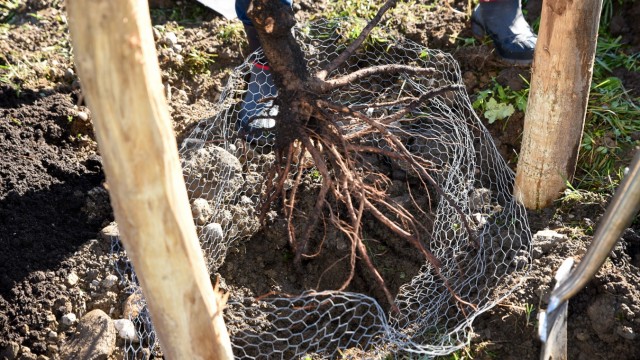
The young fruit trees on the fruit variety ark area will hopefully soon take root.
(Photo: Harry Wolfsbauer)
Georg Loferer is such an expert when it comes to old fruit varieties. The 34-year-old from Rohrdorf am Inn actually studied forestry and wood science. But then came further training to become a pomologist, i.e. an expert in fruit varieties. His specialty is the old varieties of the Alpine foothills. “I’m self-taught,” says Loferer. His uncle’s very old orchards, which he later took over, sparked the passion that has accompanied him ever since. “I was allowed to sell what I harvested at the market.” The pocket money came just in time. Little by little he dealt with the varieties in order to be able to meet the wishes of his customers.
Loferer was fascinated by the various properties of apples and pears. After his studies, the government of Upper Bavaria approached him and commissioned him to map old varieties. At first, the pomologist says, he wanted to do things methodically. “But that didn’t work. I drove to people at random. That was actually quite exciting.”
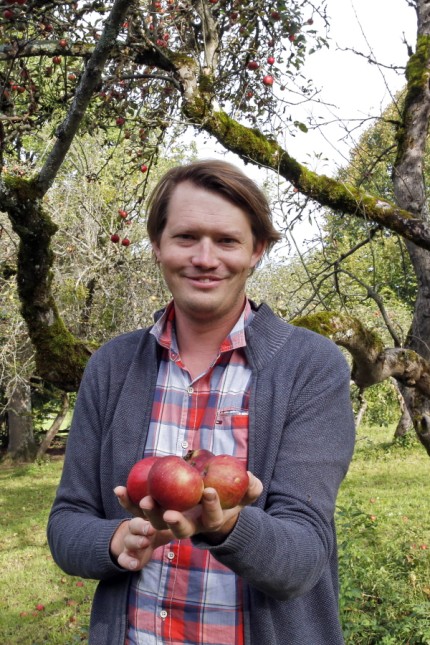
In 2020, the pomologist Georg Loferer identified old apple varieties in a garden in Ambach, here the “Danziger Kant”.
(Photo: Hartmut Pöstges)
Now there are apples and pears that no one can classify anymore. Over the decades, their names have been lost or given new ones – sometimes the same variety has different names in different regions. Like a detective, Loferer used old descriptions, paintings, the knowledge of other experts and much more. And when all that didn’t help the Sherlock Holmes of old fruit varieties, he resorted to the genetic fingerprint of apples and the like. In 2019, 350 genetic tests were compared with the Swiss genetic database (pears) and the German genetic database for fruit (apples) – with financial and organizational support from the State Agricultural Institute. For this purpose, leaf samples were collected and sent in during the summer and autumn months.
As a result, 59 apple and twelve pear trees were assigned to the recorded varieties. 42 apple and 71 pear varieties remained unknown. Instead of names, they have numbers. Loferer also consulted the Bodensee Fruit Growing Competence Center in Bavendorf, apple pope Hans-Joachim Bannier from Bielefeld or apple guru Anton Klaus from Oberneufnach and, last but not least, the collection Pomoretum Triesdorf.
More than 100 gardens in the Bad Tölz-Wolfratshausen district
When the project officially started, hundreds of fruit tree owners in the participating districts of Bad Tölz-Wolfratshausen, Weilheim-Schongau, Berchtesgaden, Traunstein, Rosenheim and Miesbach signed up. “The pomologist Georg Loferer traveled to the gardens to record important tree characteristics and to take fruit samples for identification,” says Anika Dollinger from the district advisory service for horticulture and land conservation at the Bad Tölz-Wolfratshausen district office. Together with her colleague Elisabeth Obermüller, she looks after the conservation garden in Benediktbeuern-Hausen.
Loferer visited more than 100 gardens in the Tölzer district and found 30 varieties worth preserving. The 34-year-old says he described 50 characteristics for each variety, including sugar and acid content, appearance and shelf life. Of course there were also distilling and drying tests with the fruit. When it comes to apples, there is more comparison material, says Loferer. Things look completely different with pears. They are at greater risk of being forgotten because many old varieties were not intended for consumption. They don’t taste good, the flesh immediately turns brown – in short: their intended purpose was to make must. Wine was also made from pears. Such varieties were widespread until the Second World War, says the pomologist. “There is still a lot to research and secure.”
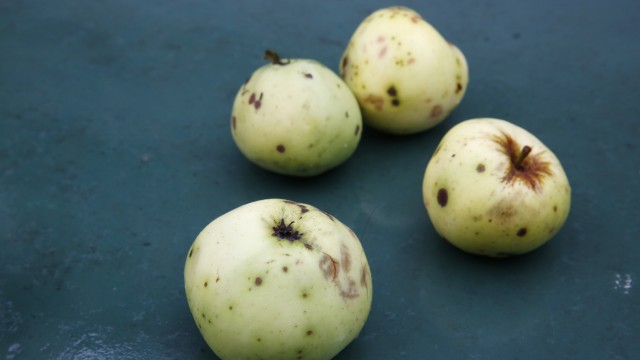
Also found in Ambach: the Grahams variety.
(Photo: Hartmut Pöstges)
Not all old varieties are resistant to diseases, but some are very robust. Loferer also emphasizes knowledge that should not be lost. Or the risk of frosts during flowering: in 2023 there were failures at Boskop and Topaz, among others. “Older varieties bloom two weeks later. I think late frosts could ruin the apple harvest this year too,” says Loferer. The historical varieties would also sometimes cope better with climate change.
Loferer did not expect to find some varieties. For example the Himbsel Rambur, an apple variety that is threatened with extinction in the Garmisch-Partenkirchen district. “There is actually a tree in Bad Tölz.” Or an old pear that can weigh up to a kilo. When Loferer talks about his finds, there’s no stopping him. He found an apple in the Geretsried/Wolfratshausen area: large, red, sweet-sour taste. There was no genetic match during the examination. “I think this is a variety from Russia that was brought back after the war,” said Loferer.
Monks and clergy who traveled from monastery to monastery would have carried travellers, as would traveling salesmen. Not to forget that it was once customary for maids, when they changed jobs, to bring their new employer twigs to refine as an inaugural gift. “So different varieties came to the farms.” Loferer is particularly pleased about the discovery of the Benediktbeuren wax reinette. It produces small, aromatic, spicy fruits. The variety is suitable for harsh climatic conditions. “For decades the variety was in the collections with the wrong name as the Schöner von Wiltshire,” says Loferer. Only an older Bichler shed light on this defining crime story. What was unexpected for him on his tour through the districts was that there were many Saxon and North German varieties, says the pomologist.
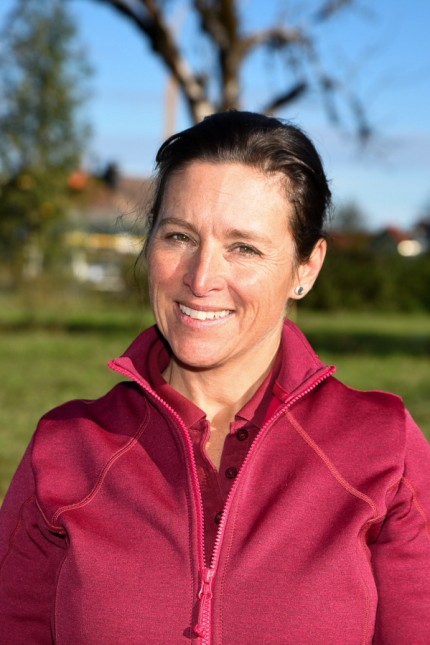
District advisor Elisabeth Obermüller.
(Photo: Harry Wolfsbauer)
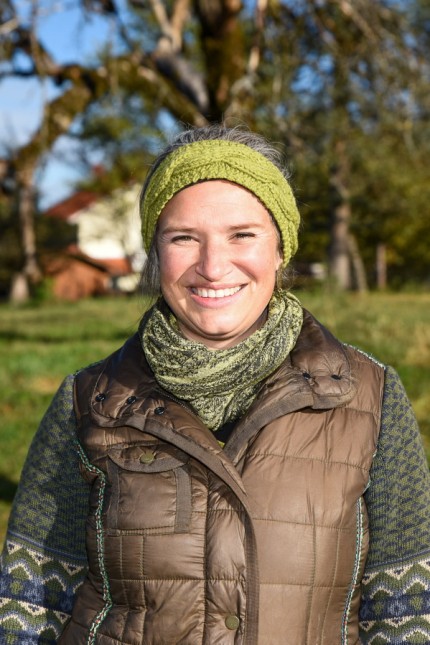
District advisor Anika Dollinger.
(Photo: Harry Wolfsbauer)
Before young trees could be planted in Benediktbeuern houses in autumn 2023, they first had to be pulled. Loferer not only determined the old varieties based on fruits, leaves and genetic analyses. He took scions, i.e. thin branches that can be used to create a genetically 100% replica of a tree variety through grafting. Loferer handed these shoots over to tree nurseries, which grew the small trees. The range of old varieties saved in this way includes a total of 270 apples and pears.
More than 60 trees have been planted in Benediktbeuern, primarily from the district. “It’s about ensuring that regional varieties don’t disappear completely,” says Elisabeth Obermüller. But that is not the only aspect: the old orchard in houses has always belonged to the Benediktbeuern monastery; the area was leased for the project by the Center for Environment and Culture. This means that a centuries-old tradition is being preserved, says Dollinger. And the ark with its ancient trees is a species-rich habitat, emphasize the two district consultants. A paradise for insects and reptiles. It is planned that the meadow will be grazed by Alpine stone sheep.
Orchard Day in April
The fruit variety ark should not be a museum that only a few are allowed to enter. There will be events there such as tours for school classes, cutting and finishing courses – in collaboration with the Center for Environment and Culture. Pomologist Loferer and project manager Eva Bichler-Öttl from the Rosenheim District Office invite you to the “Scattered Fruit Day” on Friday, April 26th, with tours and lectures in the garden in houses (2 p.m. to 5 p.m.; no registration required).
It will be years before fruit can be harvested in the conservation garden, says Elisabeth Obermüller. Loferer adds that the current focus is on breeding historical varieties. But at some point all fruit lovers can be happy, after all there should be tastings. According to Loferer, from 2025 onwards, rice plants will also be available for lovers who want to grow old varieties in their own garden.
